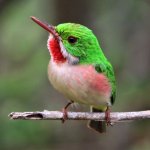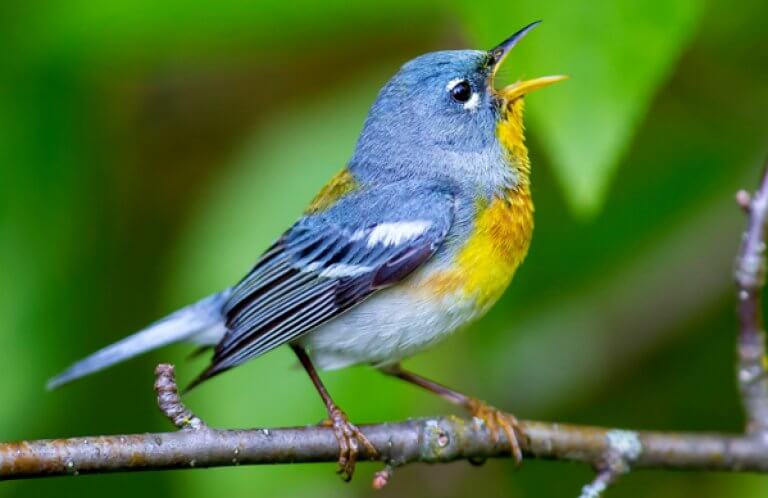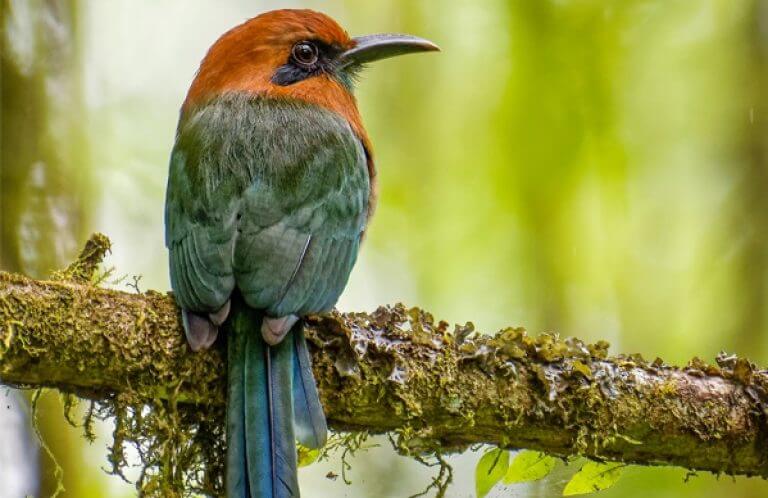About
The diminutive Broad-billed Tody is only about the size of a Northern Parula warbler — but this tropical bird has a vibe all its own. Although tiny, the tody has a proportionately large head and long bill, resembling a mini-kingfisher. As it zips through the foliage, it flashes glowing, emerald-green upperparts, a vivid red throat, fluffy pink sides, and a bright yellow-white belly and undertail.
A Caribbean Cohort
The Broad-billed Tody belongs to the family Todidae, which contains five species. All are less than five inches long, with similar coloration and features, including long, flat bills, short legs, and tiny feet. Like other insect-eating birds such as the Great Crested Flycatcher, todies have stiff, whisker-like feathers, called rictal bristles, at the base of the bill, which are thought to help them detect and capture prey. Todies belong to a larger order of birds, the Coraciiformes, which includes the Belted Kingfisher and Broad-billed Motmot.
Todies are found on certain Caribbean Islands, and nowhere else. Cuba, Jamaica, and Puerto Rico each have one endemic tody species, but Hispaniola — the island occupied by the Dominican Republic and Haiti — hosts two: the Broad-billed and the Narrow-billed. The more common of the two, the Broad-billed Tody sticks to lower-elevation habitats, while the light-eyed, slightly less colorful Narrow-billed Tody inhabits higher-altitude, wetter forests. There is some overlap between the two species, particularly in the nonbreeding season, when both may join mixed-species flocks in foothill forests. When the two tody species share habitat, they avoid direct competition by using different feeding strategies: The Broad-billed will forage at greater heights, use more open canopies, and catch larger prey. As their names indicate, the Broad-billed has a bill about twice as wide as its cousin's, suggesting that there might be some differences in how the two species secure prey.
One of the most reliable ways to separate the two Hispaniolan tody species is by voice.
Songs and Sounds
The Broad-billed Tody's main vocalization is a short, rapidly repeated “wheep.” Listen here:
Ross Gallardy, XC308611. Accessible at www.xeno-canto.org/308611
In contrast, the Narrow-billed Tody's voice is quick and raspy chatter:
Breeding and Feeding
Like other todies, the Broad-billed feeds heavily on insects, particularly grasshoppers, crickets, beetles, butterflies, bees, wasps, and ants. It also takes spiders, millipedes, tiny lizards, and other small prey, and sometimes feeds on small fruits as well.
The Broad-billed Tody, like others in its family, forages using a sit-and-wait technique known as the “underleaf-sally.” A hunting tody sits quietly with eyes and bill pointed upward, scanning for prey on the undersides of leaves. When it spots a meal, the bird quickly jumps up, snatches the prey mid-air, then lands nearby to repeat the process. The Broad-billed Tody also employs the "sally-pounce," swooping down from a perch to snatch prey from the top sides of leaves.
Barrancolí Bird
The Broad-billed Tody is seasonally monogamous, meaning that a pair remains together for the duration of one nesting season. Courtship displays include mutual chasing and “wing-rattling,” when a displaying bird's wings produce a whirring noise during flight. This peculiar sound, akin to that made by an American Woodcock, is produced by air moving through the bird's primary feathers. Other tody displays include rapidly bobbing in place while fluffing up the plumage, particularly the bright pink flank feathers.
A Broad-billed Tody pair, like its motmot or kingfisher kin, digs a nest burrow in a sandy bank or cliff using beaks and feet. The one- to two-foot-long nest burrow ends in a chamber where the female lays, on average, four eggs. Both male and female tend the eggs, taking turns brooding for two to three weeks, then assiduously feed the hatchlings, which fledge in roughly the same amount of time.
Its peculiar nesting habits earned the Broad-billed Tody the Spanish nickname “barrancolí” in the Dominican Republic (barranco means “bank” in Spanish), and “perroquet de terre” in Haiti (French for “parrot of the earth”). In both countries, this bird is also called “colibri,” a word for hummingbird.

Region and Range

The Broad-billed Tody is found only on the island of Hispaniola and is most common in the Dominican Republic. It favors lower-elevation habitats than its Narrow-billed cousin, including open woodlands, thorn scrub, coffee and cacao farms, and large gardens. It is a sedentary (nonmigratory) species.
Conservation
While its population remains large and widespread, the Broad-billed Tody is believed to be declining due to habitat loss, particularly clearing for agriculture.

Help support ABC's conservation mission!
ABC recently supported the launch of the world's first certified Bird Friendly® cacao products, a result of connecting partner Zorzal Cacao in the Dominican Republic with the Smithsonian Zoo and Conservation Institute. Seventeen farms that sell their cacao to Zorzal Cacao became the first to receive Smithsonian's new Bird Friendly® certification, which ensures farms are managed in ways that optimize their acreage for birds. Plans are ongoing to work with more local farmers to restore degraded cacao farms and get even more acres certified.
Zorzal's 1,019-acre private reserve, established in 2012, protects crucial habitat in ABC's Septentrional BirdScape for native birds such as the Broad-billed Tody and for migratory species including the Bicknell's Thrush and Black-throated Blue Warbler. About 70 percent of the Reserva Privada Zorzal is “forever wild,” while the other 30 percent is dedicated to sustainable cacao agroforestry that helps fund habitat restoration and management efforts.
Get Involved
Many of the rarest bird species in the Western Hemisphere remain relatively unknown. You can learn more about these birds and the threats they face by signing up for ABC's Bird of the Week email series, which frequently highlights these fascinating birds.
American Bird Conservancy and our partners throughout Latin America and the Caribbean have created and expanded more than 100 bird reserves, which protect upward of 1.1 million acres of vital habitat. Together, we've planted more than 7 million trees, helping to restore degraded and damaged habitat. You can help us continue to protect endangered birds by making a gift today.





















































